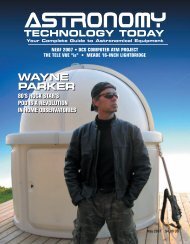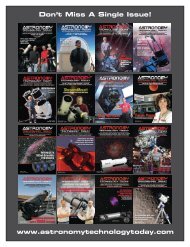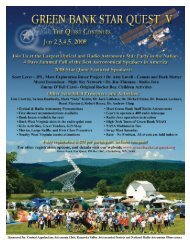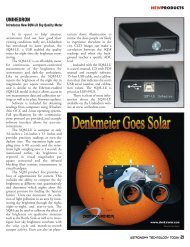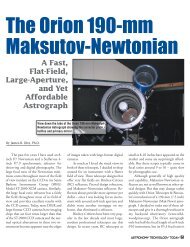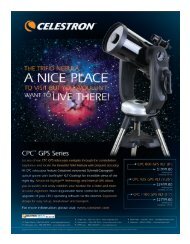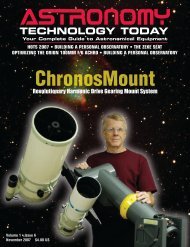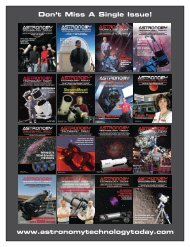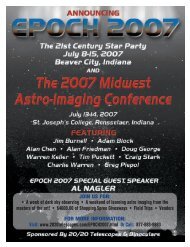magnilux - Astronomy Technology Today
magnilux - Astronomy Technology Today
magnilux - Astronomy Technology Today
You also want an ePaper? Increase the reach of your titles
YUMPU automatically turns print PDFs into web optimized ePapers that Google loves.
PROTOSTAR’S FLOCKBOARD<br />
Image 2 Image 3<br />
mentioned paint and then painted over<br />
again, cork painted black, black velvet…I<br />
even knew someone who used fingernail<br />
clippings and a Renaissance recipe for black<br />
egg tempera. (Not really.)<br />
Flat-black paint, with a reflectivity<br />
around 5% according to ProtoStar, is the<br />
most one can accomplish, and most commercial<br />
reflectors do just that. Flocking a<br />
telescope with a material like ProtoStar’s<br />
can significantly reduce the reflectivity, to<br />
around 1% (again, according to Bryan).<br />
Flocking can make a noticeable difference<br />
at the eyepiece and yet many amateur astronomers<br />
won’t attempt it. I have used<br />
self-adhesive flocking material before and<br />
although it works quite well, it’s not easy<br />
or fun to work with. I don’t have the patience<br />
to slowly wind it down a tube in a<br />
long strip or slowly peel the backing. I have<br />
nightmares of it folding onto itself.<br />
Moreover, I’ve seen scopes at star parties<br />
that were flocked years ago and the<br />
endless cycles of heating/cooling and dewing/drying<br />
have left the material bubbly<br />
and crummy looking. I have no idea if that<br />
was Protostar flocking material or not, but<br />
the images stuck in my head. I know we<br />
should look through telescope and not at<br />
them, but honestly, I like a neat tube. Telescopes<br />
are, as Steven Overholt suggested,<br />
spaceships, and I would want my spaceship<br />
to look snazzy and neat and precise, not<br />
bubbly and peeling. Lastly, having removed<br />
ancient adhesive from tube rings using<br />
some noxious solvent once, I’m not a fan<br />
of sticky gunk that I might someday have<br />
to scrape off in gobs from the inside wall<br />
of my telescope.<br />
The FlockBoard concept seemed to<br />
address both these concerns. When I spoke<br />
with Bryan Greer on the phone about it, I<br />
can best describe his tone as “giddy”. He<br />
was clearly thrilled with the new product.<br />
He emphasized the two biggest selling<br />
points: ease of use and reversibility. The installation<br />
process he described was simple:<br />
first, remove the primary mirror and cell,<br />
spider and secondary, and focuser. Figure<br />
out the circumference by multiplying the<br />
tube diameter by π. Measure the length of<br />
the tube to be flocked and cut the board to<br />
fit. Roll it up. Put it in the tube and let it<br />
spring out. The plastic’s own springiness<br />
will keep it in place against the tube wall.<br />
Then, poke some holes using an awl for the<br />
primary cell and spider bolts, use a hobby<br />
68 <strong>Astronomy</strong> TECHNOLOGY TODAY



